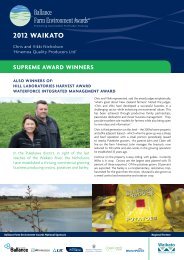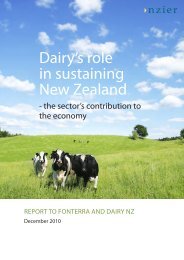NZIER report on compensation for transmission infrastructure
NZIER report on compensation for transmission infrastructure
NZIER report on compensation for transmission infrastructure
Create successful ePaper yourself
Turn your PDF publications into a flip-book with our unique Google optimized e-Paper software.
Figure 2 The effect of compulsory purchase <strong>on</strong><br />
negotiati<strong>on</strong>s<br />
$ Cumulative<br />
transacti<strong>on</strong><br />
cost<br />
Hold-out a d<br />
Price<br />
Backstop c<br />
Price<br />
Source: <str<strong>on</strong>g>NZIER</str<strong>on</strong>g><br />
b<br />
0 Limit* Limit<br />
Time & transacti<strong>on</strong>s<br />
In Figure 2 the transacti<strong>on</strong> costs are depicted as a cumulative line (i.e. the critical<br />
issue is the vertical positi<strong>on</strong> of points <strong>on</strong> the line, not the area under the line). The<br />
mirror image of that cumulative transacti<strong>on</strong> cost line – ab – represents the value<br />
obtained from realising the hold-out price after increasingly protracted negotiati<strong>on</strong>s:<br />
at zero transacti<strong>on</strong> cost the full hold-out price is received, but the net return then<br />
diminishes as transacti<strong>on</strong> costs rise. In the presence of a back-stop price it is the<br />
difference in the net hold-out price and the back-stop that determines the limit to<br />
which it is worthwhile to pursue the hold-out price. In Figure 2 that limit is determined<br />
by point c when there is a back-stop price and by point d when there is no back-stop.<br />
So the threat of compulsory purchase can be expected to shorten landowners‟<br />
willingness to negotiate and result in them settling <strong>for</strong> less than they would prefer in a<br />
negotiati<strong>on</strong> unc<strong>on</strong>strained by compulsi<strong>on</strong>.<br />
How much that happens in practice is a moot point. Transpower depends <strong>on</strong> its<br />
relati<strong>on</strong>ships with the owners of lands it crosses over the l<strong>on</strong>g life of its <strong>infrastructure</strong>,<br />
and it is not in its interests to treat them badly in the negotiati<strong>on</strong>s: aggrieved<br />
landowners can be an irritant <strong>on</strong> the smooth running and maintenance of lines <strong>for</strong> a<br />
l<strong>on</strong>g time (e.g. by obstructing access with inadvertently locked gates or frisky bulls in<br />
paddocks that maintenance pers<strong>on</strong>nel must use). As Transpower can pass <strong>on</strong> the<br />
cost of its easements to its customers and still recover its Weighted Average Cost of<br />
Capital it has another incentive not to minimise easement payments.<br />
The possibility that Transpower may pay generously to secure easements, or<br />
purchase them earlier than would be required <strong>for</strong> an optimal acquisiti<strong>on</strong> programme,<br />
is recognised in recent rule changes. Now Transpower is required to obtain approval<br />
be<strong>for</strong>e an easement can be introduced in its capital base, from the Electricity<br />
Commissi<strong>on</strong> (<strong>on</strong> major new investments), the Commerce Commissi<strong>on</strong> (<strong>for</strong> minor<br />
investments) or a client (to pay the bill <strong>for</strong> an easement).<br />
<str<strong>on</strong>g>NZIER</str<strong>on</strong>g> – Compensati<strong>on</strong> <strong>for</strong> transmissi<strong>on</strong> <strong>infrastructure</strong> 15
















